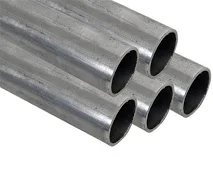The use of hydraulic cylinders made of cold drawn, seamless steel tubing is critical at temperatures below 10°C, because multiple component failure cannot be ruled out completely at this temperature or lower. Systematic investigation of ready-to-install cylinder tubes, including impact tests and drop weight tear-tests (DWTT) verified these findings.
Because impact testing does not accurately reflect true component behavior, both tests were supplemented by component burst tests to simulate realistic operating conditions. The results of the DWTT and component tests match sufficiently with regard to the lowest tolerable operating temperature and correlate with impact tests. Therefore, a minimum impact energy value can be defined for the suitability of a material for use at low temperatures.
To prevent component brittle fracture, the corresponding standard required for materials currently used to manufacture cylinders — namely, E355 and P460 — has accelerated the development of modified material variants with the lowest impact energy value. Components made of the modified steel grades exhibit a sufficiently high proportion of ductile fracture behavior at temperatures as low as -20°C. Therefore, they possess enough plastic deformation reserves to reduce the danger of multiple component failure.
The graph above demonstrates this situation using the example of the P460 and P460 modified steel grades. (These are similar to ASTM A333 Grade 10, but with 0.20% maximum V, 0.40 to 0.70 % Ni, and 1.15 to 1.70 % Mn instead of the values stated for ASTM 333 Grade 10.) The modified material allows safe operation of hydraulic cylinders at temperatures as low as –20°C.
 Afrikaans
Afrikaans  Albanian
Albanian  Amharic
Amharic  Arabic
Arabic  Armenian
Armenian  Azerbaijani
Azerbaijani  Basque
Basque  Belarusian
Belarusian  Bengali
Bengali  Bosnian
Bosnian  Bulgarian
Bulgarian  Catalan
Catalan  Cebuano
Cebuano  Corsican
Corsican  Croatian
Croatian  Czech
Czech  Danish
Danish  Dutch
Dutch  English
English  Esperanto
Esperanto  Estonian
Estonian  Finnish
Finnish  French
French  Frisian
Frisian  Galician
Galician  Georgian
Georgian  German
German  Greek
Greek  Gujarati
Gujarati  Haitian Creole
Haitian Creole  hausa
hausa  hawaiian
hawaiian  Hebrew
Hebrew  Hindi
Hindi  Miao
Miao  Hungarian
Hungarian  Icelandic
Icelandic  igbo
igbo  Indonesian
Indonesian  irish
irish  Italian
Italian  Japanese
Japanese  Javanese
Javanese  Kannada
Kannada  kazakh
kazakh  Khmer
Khmer  Rwandese
Rwandese  Korean
Korean  Kurdish
Kurdish  Kyrgyz
Kyrgyz  Lao
Lao  Latin
Latin  Latvian
Latvian  Lithuanian
Lithuanian  Luxembourgish
Luxembourgish  Macedonian
Macedonian  Malgashi
Malgashi  Malay
Malay  Malayalam
Malayalam  Maltese
Maltese  Maori
Maori  Marathi
Marathi  Mongolian
Mongolian  Myanmar
Myanmar  Nepali
Nepali  Norwegian
Norwegian  Norwegian
Norwegian  Occitan
Occitan  Pashto
Pashto  Persian
Persian  Polish
Polish  Portuguese
Portuguese  Punjabi
Punjabi  Romanian
Romanian  Samoan
Samoan  Scottish Gaelic
Scottish Gaelic  Serbian
Serbian  Sesotho
Sesotho  Shona
Shona  Sindhi
Sindhi  Sinhala
Sinhala  Slovak
Slovak  Slovenian
Slovenian  Somali
Somali  Spanish
Spanish  Sundanese
Sundanese  Swahili
Swahili  Swedish
Swedish  Tagalog
Tagalog  Tajik
Tajik  Tamil
Tamil  Tatar
Tatar  Telugu
Telugu  Thai
Thai  Turkish
Turkish  Turkmen
Turkmen  Ukrainian
Ukrainian  Urdu
Urdu  Uighur
Uighur  Uzbek
Uzbek  Vietnamese
Vietnamese  Welsh
Welsh  Bantu
Bantu  Yiddish
Yiddish  Yoruba
Yoruba  Zulu
Zulu 












